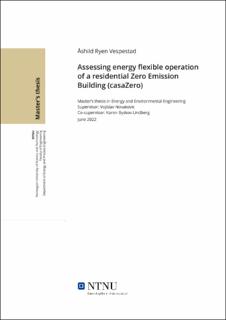| dc.contributor.advisor | Novakovic, Vojislav | |
| dc.contributor.advisor | Lindberg, Karen Byskov | |
| dc.contributor.author | Vespestad, Åshild Ryen | |
| dc.date.accessioned | 2022-10-04T17:22:36Z | |
| dc.date.available | 2022-10-04T17:22:36Z | |
| dc.date.issued | 2022 | |
| dc.identifier | no.ntnu:inspera:110284204:50543553 | |
| dc.identifier.uri | https://hdl.handle.net/11250/3023797 | |
| dc.description.abstract | Med en økende andel nyoppsatte og oppussede bygg som tilfredsstiller dagens
krav for nullutslippshus har også interaksjonen mellom bygninger og kraftnettet
økt. Bygg som både produserer og konsumerer elektrisitet, prosumers, er ofte både
importører og eksportører av elektrisitet til nettet. Av den grunn har behovet for
smart styring av laster i bygg økt i et forsøk på å senke belastningen på nettet.
Dette studiet er et bidrag til å øke kunnskapen om fleksibel drift av nullutslippshus.
Bygget som ble studert i denne masteroppgaven er et nullutslipps bolighus i Norge.
Bygget var utrustet med en bergvarmepumpe, balansert ventilasjon, solcellepan-
eler på taket og vannbåren gulvvarme. En simuleringsmodell av bygget ble laget
i IDA ICE. Ved å implementere 65 ulike timeplaner for driften av varmepumpen
i bolighuset ble påvirkningen på byggets energiprestasjon studert, med tanke på
selv-konsumering, topplast og kostnad. Fra resultatene i oppgaven ble det funnet at
selv-konsumeringen kunne økes med 13.7%. Sommeren var den årstiden som hadde
størst potensialet for videre økning av selv-konsumeringen. Ved å implementere en
last som representerte batteriet til en elbil ble selv-konsumeringen økt med 53.3%
sammenlignet med modellen uten timeplan for styring av varmepumpa. Den største
reduksjonen i topplast og kostnad var henholdsvis 50% og 9.7%. Når hver av de
tre indikatorene for nøkkelytelse ble vektlagt likt viste resultatene at varmepum-
petimeplanen med konstant verdi på 0.5 ga de beste resultatene sammenlagt. Det
ble oppdaget en sammenheng mellom de ulike indikatorne for nøkkelytelse, noe som
gjorde det vanskelig å redusere kostnadene samtidig som selv-konsumeringen skulle
økes. | |
| dc.description.abstract | With an increasing amount of new and retrofitted buildings qualifying as
ZEBs, the interaction between buildings and the grid has increased. Build-
ings that both produces and consumes electricity, prosumers, are likely to
both import and export electricity to the grid. Hence, the need to utilized
smart controlling of the electricity consumption in buildings is reinforced, as
an attempt to reduce the stress on the grid. This study is a contribution to in-
creasing the knowledge on flexible operation of ZEBs. The case building in this
research was a residential ZEB located in Norway. The building was equipped
with a GSHP, a balanced ventilation system, PV panels and water borne floor
heating. A simulation model of the case building was established in IDA ICE.
By implementing 65 different operational schedules to the GSHP the impact
on the performance of the building was analysed, regarding self-consumption,
peak load and cost. It was found that the self-consumption could be increased
by 13.7%. The summer season was found to be the most influential season
considering further increasing of the self-consumption. By introducing an addi-
tional load simulating the battery of an EV, the self-consumption was further
increased by 53.3%, compared to the case without a GSHP schedule. The
maximum reduction for peak load and cost found in this research were 50%
and 9.7%, respectively. When equally weighting the three KPIs, the results
showed that a GSHP schedule with a constant value of 0.5 gave the best over-
all result. A relation between the different KPIs were discovered, making it
challenging to decrease the cost while increasing the self-consumption. | |
| dc.language | eng | |
| dc.publisher | NTNU | |
| dc.title | Assessing energy flexible operation of a residential
Zero Emission Building (casaZero) | |
| dc.type | Master thesis | |
